Water pumps have been around for a long time. H.A Wirtz developed the first one in 1736. A stream wheel powered it to raise water for use at a dye house. Since then, water pumps have continued to evolve and are now incredibly sophisticated pieces of equipment with many applications. Industrial uses are some of the most common for water pumps. For example, industrial pump services are used to remove water at construction sites, displace water after heavy rainfall and irrigate crops. For each situation, there is a type of water pump like a vertical turbine pump that is best suited for the job.
There are two major types of water pumps; centrifugal pumps and positive displacement pumps, each with its subcategories. By understanding the different kinds of water pumps, and when they are used, project managers can make better decisions regarding which one to use.
Centrifugal Pumps
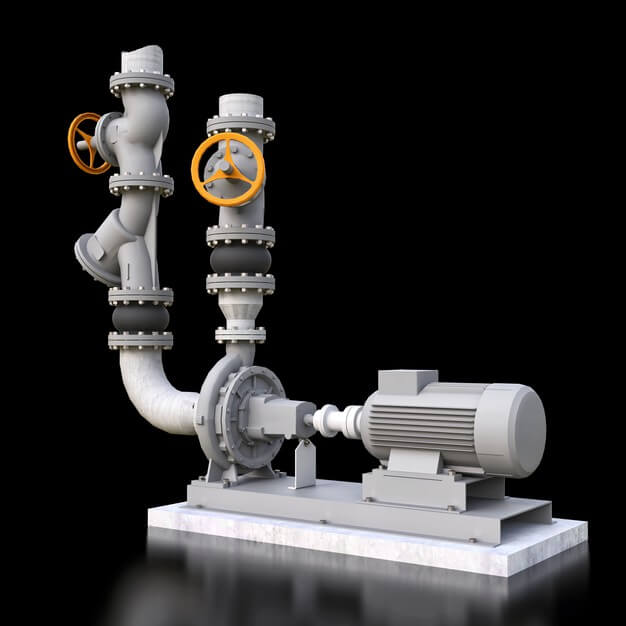
The first major type of pump is a centrifugal pump. According to Intro to Pumps, a centrifugal pump is “a machine that uses rotation to impart velocity to a liquid and then converts that velocity into a flow.” A centrifugal pump is made up of a pump shaft, a sealing mechanism, and other components to help the pump handle operation stress. Centrifugal pumps must remain filled with fluid at all times to function properly.
Inside the pump is also an impeller, which rotates to provide velocity to the liquid being pumped. This impeller spins rapidly, run by a motor, which forces the liquid in a specified direction. Centrifugal pumps come in several different kinds:
Vertical Turbine Pumps
A vertical turbine pump, also known as a vertical pump or lineshaft pump, is a centrifugal pump that transports water from deep underground. A common type of vertical turbine pump is a submersible pump, which is situated entirely underwater. With a submersible pump, the motor is located at the bottom of the system. Submersible vertical turbine pumps are often used when the liquid is far underground, such as in sewage services.
One advantage of using a submersible vertical turbine pump is the noise level. Due to being far below ground and underwater, this type of pump produces much less noise. In addition, submerged pumps do not need to be primed since they are already underwater.
Other vertical turbine pumps have their motors mounted at the top of the system, with impellers connected through a long shaft. In this configuration, the motor remains dry and is easier to maintain. Our blog post on how vertical pumps work provides a more in-depth look at this system.
End-Suction Pumps
One of the more common types of centrifugal pumps is an end-suction pump. This type of pump consists of a single impeller along with a horizontal shaft. These pumps can be altered easily to allow them to pump different types of liquids or solid materials.
Multistage Pumps
The last type of centrifugal pump is called a multistage pump. These pumps have multiple impellers, which provides the pump with additional force. This higher pressure force is required in many instances, such as pipelines.
Positive Displacement Pumps

A positive displacement pump is one where a certain amount of liquid is brought inside the pump’s cavity, and then that same amount is discharged. Depending on the type of pump, this displacement occurs either via a piston, diaphragm, or plunger. To bring the fluid in, a form of suction is used on the inlet side as the cavity expands, then discharged as the cavity decreases. Like centrifugal pumps, there are different types of positive displacement pumps, including:
Rotary Pumps
Rotary pumps run off the rotation of a rotary, which is anything that revolves around a center axis. As the rotary turns, it displaces fluid from the reservoir into the discharging pipe. Two common examples of a rotary pump include a screw pump and a sliding vane.
Reciprocating Pumps
A reciprocating pump uses a piece that moves forward and backward to transfer the fluid from the reservoir. Common examples of a reciprocating part include a plunger or a piston. As the liquid is being brought into the reservoir via suction, inlet valves open up while the outlet valves remain closed. To discharge the fluid, the inlet valves close, and the outlet valves open.
Linear Pumps
Linear pumps get their name from the fact that they operate in a straight line. A classic example of a linear pump is called a chain pump. In a chain pump, circular discs are attached to a long chain. As the chain moves up the tube, the discs carry the trapped water, where it is discharged at the top. Modern linear pumps are more sophisticated but operate on the same basic theory.
Understanding the Many Kinds of Water Pumps
When a fluid pump is required, it’s important to know which kind is best suited for the task. Choosing between a vertical turbine pump or a rotary pump will greatly impact the outcome of the task. Luckily, by working with a trusted provider of industrial pump services, such as Zone Industries, the right type of pump isn’t hard to find.
What Are the Different Types of Water Pumps? | Zone Industries
Turbine pumps perform a vital function in many industries, including construction, mining, and cool water circulation. According to Mindat.org, a turbine pump is “a pump with a shrouded impeller and receiving the water at its center. A diffusion ring containing vanes surrounds the impeller and directs the impeller discharge into a circular casing, which delivers into the eye of the next impeller in series. The diffusion ring converts the high-velocity discharge of the impeller into pressure head.” However, not all turbine pumps are the same. When it comes to turbine pumps, there are essentially two main types: submersible vertical turbine pumps and lineshaft vertical pumps. Each performs a similar function but acts differently and has its advantages and disadvantages, depending on the application. To get the right type of turbine pump for your situation, it’s important to understand how the two types of pumps function and what they have to offer.
How a Submersible Vertical Turbine Pump Functions

Submersible turbine pumps are designed to function while submerged in water. According to WaterWorld.com, “Submersible motor vertical turbine pumps use a submersible motor coupled to the lower portion of a submerged vertical turbine pump so that both are located together in the well.”
Here’s how the entire process works: First, water enters into the pump through the bottom. This portion of the pump is bell-shaped and called the “Suction Bell.” After that, the water is sent to the first stage impeller, which raises the water’s velocity. From there, the water continues onto the diffuser bowl, which is located directly above the impeller. The energy created from the higher velocity is here converted into high pressure. Simultaneously, the diffuser bowl is directing the water to the next impeller, which is located above the bowl.
After leaving the last diffuser bowl, the final stage is for the water to travel up through a long vertical pipe. At the surface is a discharge head, which changes the direction of the flow. A motor is mounted to the discharge head, pushing the water through its final stage.
This entire process runs continuously as long as there is water at the bottom, completing the journey from top to bottom in just seconds. For deeper wells, multiple impellers may be used to create more pressure along the route.
The biggest difference between a submersible vertical turbine pump and a vertical line shaft turbine is the motor placement. In a submersible turbine pump, the motor and the pump are located at the bottom of the system, submerged underwater. On the other hand, vertical line shaft pumps have the motor running at the top of the system. The motor placement has a big impact on how the turbine functions and on which type of turbine pump is ultimately right for the project at hand.
Benefits of a Submersible Vertical Turbine Pump
A vertical turbine pump submerged underwater provides a few advantages over a line shaft vertical pump. For starters, submersible pumps are typically quieter, which is an advantage if you are running the pump in a major metro area or in any other setting where the noise level is a factor. Besides this, this type of pump is less susceptible to vibration problems. Too much vibration within the system can cause breakdowns and other issues, meaning it is ideal to reduce vibrations as much as possible.
In many cases, working with a submersible vertical turbine pump is more affordable than a line shaft one, since you don’t need to install motor pedestals or line shafting. They can also operate in smaller spaces and at higher speeds, which can further reduce the costs. Finally, a submersible pump does not need a pump house for protection, as the pump is entirely underwater at the bottom of the system.
Benefits of a Line Shaft Vertical Pump

Of course, there are a few advantages to choosing a line shaft vertical turbine pump as well. For example, maintenance on the motors is often easier on line shaft vertical turbine pumps, as the motor is located at the surface rather than at the bottom of a well. In addition, line shaft pumps are often more efficient and less susceptible to failures that result from voltage issues.
Lastly, line shaft pumps are more versatile. You can run a line shaft pump with a vertical motor, a horizontal motor with a right-angle gear drive, a pulley system, and more. More fuel sources are available, as the motor is located above the water and on the surface.
The Right Pump for the Situation
When it comes to picking a turbine pump for a job, there is no one set answer. Each job has its circumstances, including location, budget, and other equipment available. Based on this, project managers must choose the turbine pump that makes the most sense for their project. By understanding how a turbine pump functions and the difference between the types of vertical turbine pumps, project managers can decide the best way to proceed.
How Does a Submersible Vertical Turbine Pump Function? | Zone Industries
All commercial facilities need some plumbing, but some industries require a more heavy-duty system. If you have to move water against the natural flow of gravity, you’ll need a pump system. Hydroflo pumps are an excellent option due to their reliability and specific design.
Why does it matter what type of pumping system you have? While basic setups may move cold water, as the temperature rises, so do the complications. Heat, steam, and pressure can all impact a pumping system’s integrity, which is why you must understand how the available pump options work.
What Are Hydroflo Pumps?

Hydroflo Pumps is the name of a pump system manufacturing company and can also refer to its products. The company creates equipment for a variety of industries and purposes:
- Nuclear plant cooling
- Mine dewatering
- Agricultural water supplies
Turbine pumps allow business owners to precisely control the amount of water moved, especially in chemically volatile situations such as nuclear power generation.
Parts from Hydroflo Pumps are designed and manufactured to the highest quality standards no matter which industry they’re bound for. They can be made of lead or stainless steel, depending on business owners’ needs.
What Are the Types of Turbine Pumps?
There are two different types of turbine pumps that can move water from a lower level to a higher ground: vertical and submersible. While both accomplish the same task, they’re structured differently and therefore have different pros and cons.
How do you know which one will work for your situation? To make the best decision, you need to understand how each type functions, so let’s start with an overview of their structures.
Submersible Turbine Pumps
You may have guessed from the name, submersible turbine pumps are installed below the water level. Specifically, the pump and motor are placed close together and completely submerged. Motors can be hydraulic or electric and are hermetically sealed to prevent damage.
In order to move water from a lower elevation to a higher level, submersible turbine pumps rely on energy conversion. Water and other liquids possess kinetic energy as they’re taken into the pump. As they move through the centrifugal pump’s multiple stages, that kinetic energy becomes pressure energy, which can be used to move the liquids against the pull of gravity.
Vertical Turbine Pumps
One thing to remember is that although submersible and vertical turbine pumps have different names, they both move liquids up and therefore contain vertical structures. You may wonder, then, what the main functional difference is between the two. The answer is motor placement.
In a vertical pump, the motor is above ground. It’s connected to the pump via vertical line shafts. Motors are usually electric or diesel and couple with the submersed pump to create pressure via suction.
What Type of Hydroflo Pumps Should You Use?
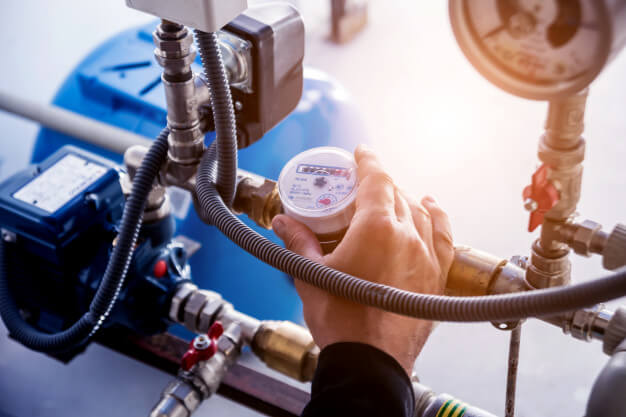
So why does motor placement matter? When considering submersible vs. vertical, it’s really about convenience vs. efficiency. Which is most important to you will determine the best option.
Advantages of Submersible Turbine Pumps
Submersible turbine pumps don’t require motor protections such as pump houses because they’re already sealed away from harm. Their working principle also allows them to function with fewer pump bowl stages, which means a more compact system. The lack of line shafts means easier installation and a lower initial cost. If you’re seeking for a fast solution that takes up as little space as possible, the submersible pump is for you.
Advantages of Vertical Turbine Pumps
Although more expensive and complicated, vertical turbine pumps have their advantages. For one, they’re less likely to fail, as they’re less susceptible to voltage surges. Additionally, they’re more efficient, as they tend to be more powerful than their submersible counterparts. If you want a pumping system that works hard every day, a vertical turbine pump is the best choice.
Why Choose Hydroflo Pumps?
No matter what type of Hydroflo pumps you choose, you know they’ll get the job done right. That’s why the experts here at Zone Industries offer Hydroflo Pumps products — we only sell products that we would trust in our businesses.
Are you looking for a pump system? You can find a wide variety of top brands on our website. Whether you need to move oil, gas, grease, or old water, we offer a system that’s up to the task.
How Submersible Turbine Hydroflo Pumps Work | Zone Industries
The use of Hydroflo pumps and other water pumping systems is relatively standard across the majority of industrial and commercial facilities. However, in most circumstances, basic operations require the pumping of cold water, a natural lubricant for the pump system, and only low-pressure components.
When a company requires the pumping of hot water, it needs to address viscosity and vapor pressure changes. The differences between water at 68 degrees Fahrenheit and 176 degrees Fahrenheit seem minimal in measurement. Still, the composition of hot water makes it lighter and less lubricating while drastically increasing the system’s pressure because of vaporization. The changes only increase the increasing water temperature, which means that companies must understand how these changes affect the pumping system and what changes need to occur to prevent damage or early deterioration of pump components.
The Effect of Heat on Pumps

Most pump operators are familiar with the net positive suction head available for a specific pump. However, do not trust the stated NPSHA on specific vertical turbine pumps without first purchasing an NPSH test for the exact operating conditions. While a pump manufacturer may claim an NPSH, the numbers are not guaranteed without a confirmation test because of variation in uses and how depth and temperature can impact different pump components.
Hot water systems have an increased risk of cavitation, which is the rapid change in water pressure leading to metal wear. As liquid accelerates through the suction pipe, bubbles form as the pressure drops. The system forces the water from the line to the impeller eye. The pressure suddenly increases, forcing the bubbles to collapse, creating a tremendous amount of localized pressure and causing minor abrasions on the metal propeller. A stainless steel impeller has more resistance to these moments of cavitation.
Expansion and Pipe Components
The majority of centrifugal pumps can handle the temperature and water fluctuations of 250 degrees Fahrenheit. Still, as temperatures rise toward 300 degrees Fahrenheit, these systems struggle to keep up with the dramatic expansion. When working with temperatures above 250 degrees Fahrenheit, professional organizations recommend using Hydroflo pumps with centerline-supported casing.
Using systems with specialized casings allow for thermal expansion from its center of rotation. The allowance for expansion out from the center means that components maintain the same axis throughout the pressure and temperature changes. Because these systems are not fixed to the pump base vertically, pump owners experience fewer alignment problems than other casing designs.
The Necessity of Balance
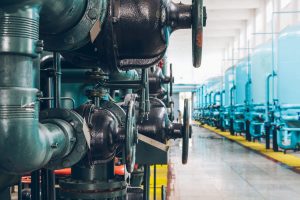
For operations above 220 degrees Fahrenheit, a balanced seal is necessary for all pumps, even submersible turbine pumps. The balance ensures the proper operation at higher temperatures, but even correct seal usage is no match for temperatures above 250 degrees Fahrenheit. When reaching such temperatures, companies should consider Viton, Ethylene Propylene, Aflas, or Kalrez. However, while some of these materials will help balance the system, anytime water reaches above 250 degrees Fahrenheit, the system requires additional cooling. While a cooling jacket can help, a flush is better.
Avoiding Bearing Failure
Some pump operators worry about the bearings in hot water applications, but the added concern is unwarranted with most systems. The obsession with cooling the bearing frame can often cause the damage operators want to avoid. Excessive cooling can cause condensation and contamination of the lubricating oil, which leads to early bearing failure. To prevent such damage, only use precautionary cooling measures in operations over 500 degrees Fahrenheit.
The Importance of Pump Selection
Despite the increased concern for hot water pumping, the process is not complicated. Selecting the appropriate Hydroflo pumps, cooling system, mechanical seals, and pipes will ensure prolonged operations. When selecting and customizing your pumping solution, the primary consideration is water’s changing properties in increasing temperatures. Understanding the viscosity and pressure of heated water can prevent system failure, which equates to a safer work environment for all involved.
There is no need to decide on a pumping solution on your own. A Zone Industries representative can help you calculate your company’s needs, ensuring that the pump can handle your hot water operations. Instead of wondering about pump design specifications, contact Zone Industries to go over your system requirements, allowing experts to assess your process and needs. With a consultation and system assessment, you can be confident in the final installation and operation.
Understanding the Effects of Hot Water on a Pump System | Zone Industries
The process of industrial and commercial manufacturing requires the use of several different pumps, including AllFlo pumps. It is challenging to keep track of the various types of pump systems and applications. However, this article aims to identify 15 popular systems and provide a brief overview of each.
1. Centrifugal Pumps
A centrifugal pump has one or more impellers and is useful in many different applications. These pumps have the highest flow rates and can handle clean or dirty liquids. However, these devices will not work well for thicker liquids, like oil.
2. Regenerative Turbine Pumps
While a part of the same classification, regenerative turbine pumps are not considered a proper centrifugal pump. However, these models still use the same kinetic principle, but most are single stage. These devices’ best applications are small commercial boiler systems, like those found in dry cleaners or bakeries.
3. Submersible Pumps
If you require deep water or sewer operations, ask All-Flo Pump distributors about submersible pumps. These tools have an encased and protected motor with a single-stage pump, allowing the entire device to operate while submerged.
4. Vertical Turbine Pumps
A vertical turbine pump is versatile. While the design’s purpose is to operate in a bore-hole well, these sophisticated vertical shaft pumps can also pump from an intake structure, open reservoir, river, or tank. You can also use the pump as a booster pump mounted to the inside of a barrel.
5. Positive Displacement Pumps
While you can search for systems with the right All-Flo pump parts, you might find more luck working with a positive displacement pump. The positive displacement pump doesn’t rely on impellers to propel liquids through the system. Instead, it rotates or uses reciprocating parts to transfer materials.
6. Flexible Impeller Pump
A flexible impeller pump is likely what you need when a positive displacement pump is not enough and requires extra propulsion. The flexible impeller conforms to a displacement pump’s parts, allowing thin liquids’ easy transportation, even those containing some solids.
7. Piston Pumps
Piston pumps use pistons to create high pressure. These pumps provide adequate pressure for wash down services in oil production. Many people are familiar with these systems even if not aware of the name because they are used for pressure washing.
8. Lobe Pumps
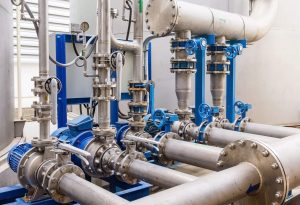
When pumping viscous liquids containing soft or fragile liquids, lobe pumps provide the right amount of pressure. These pumps use two shafts to drive the lobes, which mesh but never touch, to pump the liquids gently. The food, beverage, and pharmaceutical industries find these devices most useful.
9. Gear Pumps
Like a lobe pump, a gear pump also uses two meshing gears, but the types are both internal and external. These pumps are not suitable for transporting abrasive liquids or those containing solids. The device is best for clean oils and other high viscosity liquids.
10. Diaphragm Pumps
Like some AllFlo pumps, diaphragm pumps use a reciprocating diaphragm driven by a fluid drive, solenoid, or mechanical drive. These tools also use inlet and outlet check valves. The diaphragm pump is useful in plants because of the varying materials it can handle, from those containing solids to corrosive substances.
11. AODD Pumps
If your pumping operation is not near electricity, then you may need to use air-operated systems instead. An AODD pump runs on air and is useful in construction projects, like concrete pouring.
12. Well Pumps
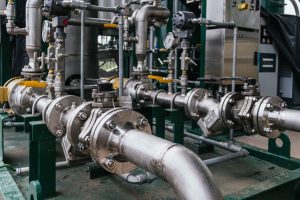
If you are more interested in rural operations, like irrigation, you may want to invest in a well pump. The well pump is a vertical turbine pump and is used in bore-hole applications.
13. Trash Pumps
A trash pump is a dewatering pump. It can be self-priming or submersible, and the design allows the unit to handle rocks and other solids. These pumps often find use in mining or construction operations.
14. Self-Priming Pumps
Self-priming pumps offer an advantage because they do not need to be submerged. These pumps have motors that rest above the reservoir and do not require external priming or foot valves.
15. Magnetic Drive Pumps
When looking for AllFlo pumps, consider the temperature and sealing issues of the substance. Magnetic drive pumps are sealless, which is advantageous when dealing with non-viscous or heat transfer fluids.
What type of pumping solution do you need? Contact a Zone Industries representative to discuss your business and operations.
Overview of 15 Popular Pumps, Including AllFlo Pumps | Zone Industries
